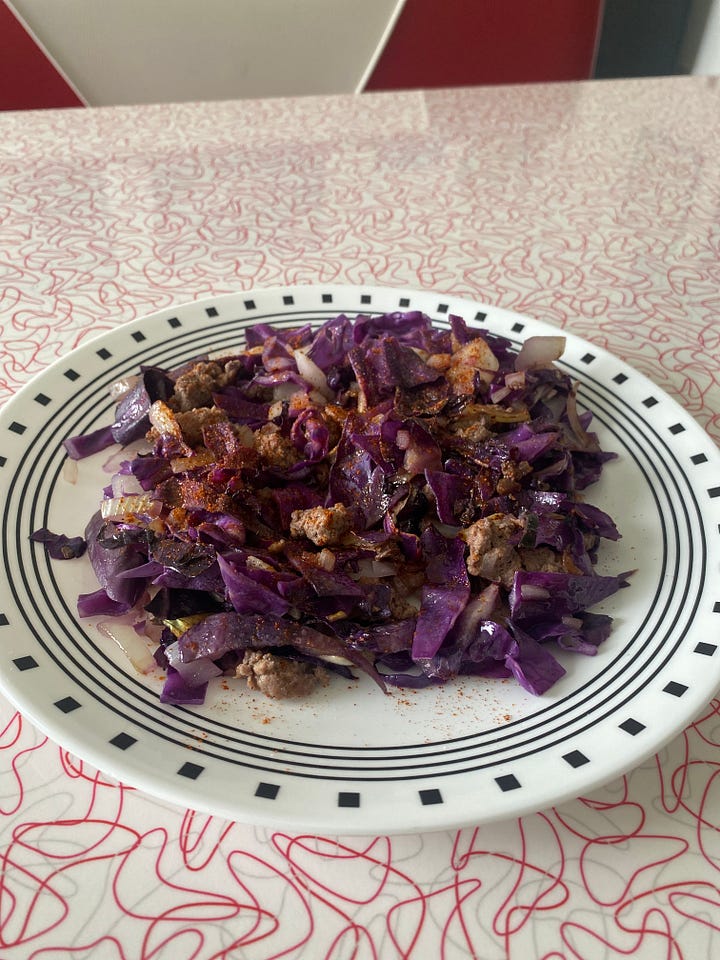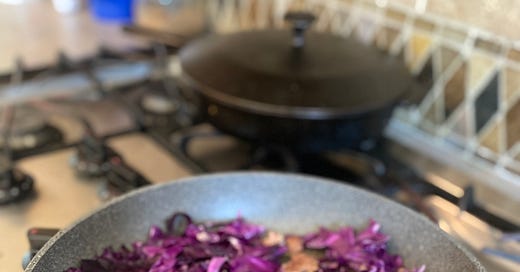

Woven into the broad palate of colors that paint our universe, purple holds a place of profound significance, especially in Eastern philosophy where it is deeply interwoven with the concepts of wisdom, spirituality, and royalty.
My own journey with the color purple began in the humble realms of my cooking journey, where the vibrant shades of purple cabbage captured my heart. This fascination isn't just aesthetic; it's rooted in the rich mosaic of history and the myriad health benefits these colorful leaves offer.
Purple, historically, has been a color of rarity and regality. In ancient times, the dye required to produce purple garments was so outrageously expensive and labor-intensive to produce that only the highest echelons of society could afford it. This connection with royalty was mirrored in the Eastern world, particularly in China and Japan, where purple was often associated with nobility and the divine.
From a philosophical standpoint, Lao Tzu, the founder of Taoism, might have seen purple as a symbol of the harmony between the yin and yang. This color, which beautifully blends the calm stability of blue and the fierce energy of red, could be seen as embodying the fundamental Taoist principle of balance.
Then there is Confucius, who might have appreciated purple's representation of nobility—not in the hierarchical sense, but as an ideal for moral integrity and wisdom.
Recently, I was reintroduced to deep hues of purple cabbage at a local grocery store I frequent in Fort Collins. This vegetable not only added a splash of color to my plate but also brought a host of health benefits. Rich in vitamins C and K, and packed with antioxidants, purple cabbage is a testament to the notion that what is beneficial to the body can also be pleasing to the eye.
With this, there is a philosophical lesson akin to the teachings of Lao Tzu—harmony in what we see and what we consume can contribute to a balanced life.
Moreover, the evolution of the color purple in society, from a symbol of inaccessible luxury to a common color in everyday life, reflects a broader democratization of health and well-being. Where once only emperors wore purple, today, many can enjoy purple fruits and vegetables that support good health.
Other significant purple things include lavender, amethyst, and the twilight sky—each carrying its own symbolic weight. Lavender, with its soothing scent, is often associated with tranquility and healing, aligning well with Confucian ideals of inner peace and self-care. Amethyst, a purple gemstone, is believed in many cultures to purify the mind and alleviate stress, echoing the meditative practices encouraged by Lao Tzu.
The impact of purple on health extends beyond visual pleasure. Scientific studies suggest that anthocyanins, the pigments that give purple cabbage its color, may have anti-inflammatory properties, potentially reducing the risk of heart disease and bolstering brain health. This link between color and health might not be explicitly outlined in Eastern philosophies, but it certainly aligns with their holistic approach to wellness—caring for the mind, body, and spirit.
Purple cabbage, with its vibrant hue and crisp texture, is a versatile ingredient that elevates both the visual appeal and nutritional value of many dishes. A classic use of purple cabbage is in coleslaw, where it adds a pop of color and a peppery punch to the creamy, tangy flavors of the salad. It's also a star whenever I prepare a stir fry dish, contributing a satisfying crunch and a beautiful contrast to the greens and oranges of bell peppers and carrots.
For a heartier dish, consider incorporating purple cabbage into braised recipes, such as alongside pork or beef, where it absorbs the rich flavors of the meat while maintaining its structural integrity. Additionally, it makes an excellent addition to fish tacos, providing a fresh, crunchy counterbalance to the soft textures and mild flavors of the fish.
Each of these dishes showcases the adaptability of purple cabbage, making it a beloved choice for chefs and home cooks aiming to enhance their meals with both color and nutrition.
As we contemplate the color purple's role in our lives and its philosophical undertones, we find that it offers a unique lens through which to view our world—one that blends history, health, and aesthetics. Lao Tzu and Confucius, with their profound insights into the nature of balance and ethical living, would perhaps agree that embracing the deeper significances of colors like purple can lead to a more thoughtful and harmonious way of life.
The journey through the realms of purple—from regal ancient courts to the vibrant layers of purple cabbage in dishes that I prepare—reflect a deeper philosophical narrative, one that traverses balance, health, and the universal quest for wisdom. As we embrace the purples of our world, we connect not only with a color of historical royalty but with a timeless philosophy that continues to enrich our modern lives.
The Chocolate Taoist is a reader-supported publication. To receive my now daily reflections and support my independent writing journey, please consider becoming a subscriber or financial supporter.
Any $6.00/month or $60.00/year, every little bit counts.
PS: My book “The Way of the Chocolate Taoist” is set to release on September 1, 2024. A free copy will be sent to all paid member supporters.





Purple is the best color, imo. My business is called Purple Room Yoga, because I teach online from my purple room. People who like purple are usually all in with purple everything. I wear purple yoga clothes, purple scrubs when I see acupuncture patients, with a purple clipboard and a purple tea cup. I do write in black pen because, well, rules, but purple is my color. 💜